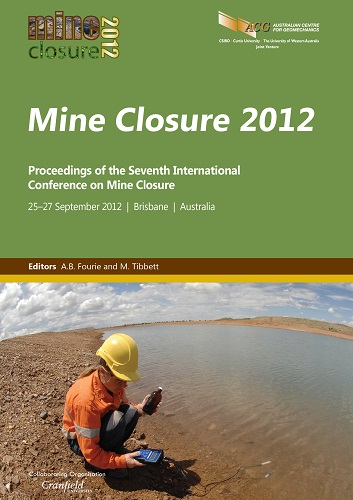A successful heap leach reclamation under extreme conditions – a case study

|
Authors: Robledo, MF Paper is not available for download Contact Us |
DOI https://doi.org/10.36487/ACG_rep/1208_29_Robledo
Cite As:
Robledo, MF 2012, 'A successful heap leach reclamation under extreme conditions – a case study', in AB Fourie & M Tibbett (eds), Mine Closure 2012: Proceedings of the Seventh International Conference on Mine Closure, Australian Centre for Geomechanics, Perth, pp. 317-327, https://doi.org/10.36487/ACG_rep/1208_29_Robledo
Abstract:
The Tambo Mine is located in the IV Region of Chile, approximately 180 km east of La Serena in the Chilean Andes, close to the Argentinean border at approximately 4,040 metres above sea level (masl). Through its life, the property has had several owners. Barrick Gold Corporation acquired the property in 1994. The Tambo open pit mining/milling operation began in 1995 and ceased in 2000. In 2001, Chilean authorities approved the Tambo Mine Closure Plan submitted by Barrick. Closure activities at El Tambo Mine included the reclamation of a pre-existing heap leach facility that operated between 1986 and 1994. This facility has a total area of 7.5 ha and contains approximately 3 million tonnes of cyanide leached ore. The climate is typically mountainous, type tundra, characterised by major diurnal variations in temperature; the peak summer maximum temperature is 24°C, and the winter peak minimum temperature is -21°C. Precipitation occurs mostly as snow during April to September; peak annual snow fall range up to 817 cm. This paper documents the heap leach reclamation under these extreme conditions in order to develop and implement the most appropriate engineering solutions for the closure to fulfil the objective of “to prevent and reduce the risks for human health and the environment, as the result of the closure and subsequent abandonment of the mining facilities”. Activities included slope re-grading, the construction of a cover system, and construction of surface water management infrastructure. In addition, a passive water treatment facility was constructed to manage the residual effluents chemistry (cyanide content) to comply with discharge limits.
References:
Aguirre, G., Jones, T. and Robledo, M. (2009) A pilot case study for passive water treatment at the El Indio mine, in Proceedings 1st International Seminar on Environmental Issues in the Mining Industry, J. Wiertz and C. Moran (eds), Chile, pp. 62–64.
Decreto Supremo No 90 (2001) Norma de Emisión para la Regulación de Contaminantes Asociados a las Descargas de Residuos Líquidos a Aguas Marinas y Continentales Superficiales, Ministerio Secretaría General de la Presidencia de la República, Gobierno de Chile.
Dirección General de Aguas (1995) Manual de Cálculo de Crecidas y Caudales Mínimos En Cuencas Sin Información,
Golder Associates (2010) El Tambo Mine Closure Design for Heap Leach, prepared for Compañía Minera Zaldivar S.A.
MWH (2003) Montgomery Watson Harza, Plan de Cierre Pila de Lixiviación Minas Tambo, preparado para Compañía Minera El Indio.
© Copyright 2025, Australian Centre for Geomechanics (ACG), The University of Western Australia. All rights reserved.
View copyright/legal information
Please direct any queries or error reports to repository-acg@uwa.edu.au
View copyright/legal information
Please direct any queries or error reports to repository-acg@uwa.edu.au